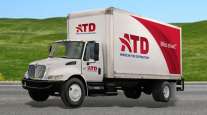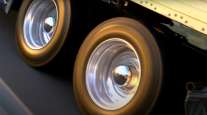Senior Reporter
Proper Tire Inflation Saves on Fuel, Equipment Costs

[Stay on top of transportation news: Get TTNews in your inbox.]
AUSTIN, Texas — Ensuring that truck tires are properly inflated not only saves on fuel and tire wear, it also contributes to environmental sustainability and helps provide driver satisfaction and safety, according to a panel of trucking maintenance executives.
They were speaking at an Oct. 16 session at the 2023 American Trucking Associations’ Management Conference & Exhibition, which was held Oct. 14-17.
“Of course, we all know fleet operators always are trying to look for opportunities to save another fraction of a penny, wherever that may be,” said session moderator Seth Clevenger, managing editor of features at Transport Topics.
The tire monitoring session was aimed at moving beyond some of the practices that the industry has used for many years. Tire pressure monitoring is one of the maintenance factors that “are a little more underappreciated,” Clevenger said.
Kicking the tire doesn’t work anymore.
“For us, we have such a wide base of customers,” said Chris Hough, vice president of maintenance, design and engineering at Penske.
Trimble CEO Rob Painter discusses the company’s continued investment in the freight transportation industry and its vision for a more connected supply chain. Tune in above or by going to RoadSigns.ttnews.com.
“The statistics of it tells you if a tire is properly inflated it’s going to roll better, roll easier and will save from 1% to 1.5% in fuel consumption.
“But safety has to be at the forefront. Statistics show that the majority of tire failures, 80%, fail because of heat. Heat results from low inflation, which drives wear on the tire.”
“We were early on adopters looking at our tractors with the expectation to maintain tire pressures,” said Mike Gomes, vice president of maintenance at Bison Transport. “It was part of a best practice, pre-trip inspections, making sure that vehicles are ready to go. But not being able to rely on that fully, you’re not able to tell if a tire is at 100 [pounds per square inch], 105 psi or 85 psi. They all look really similar.”
So several years ago, Bison took a look at auto inflation, tested it and found it saved 1.6% in fuel consumption.
Want more news? Listen to today's daily briefing above or go here for more info
“Definite fuel savings, and it’s the right thing to do,” Gomes said. “Our drivers really interact well with the systems.”
Said Dennis Elford, director of maintenance and engineering for UPS Inc.: “By carefully maintaining proper tire pressure, UPS got up to 15% more tread wear.”
UPS has about 120,000 vehicles in its fleet, and Elford said that with the proper air pressure, the package carrier is able to extend casing life.
“It’s very important that we take care of the tires for money saved, but also for safety out on the road,” Elford added. “You have to think about your driver and your outside service. We don’t want to be out there at 3 in the morning on the side of the road just for changing a tire.”
So how big a line item are tires?
“It’s one of the top two costs that we have,” Hough said. “It’s one of the things we have to constantly monitor and check. We use many inflation systems. We need to be proactive.”
Gomes added, “In our fleet when we look at it, it’s one of our biggest costs next to labor, with about 30% in over-the-road repairs,”






